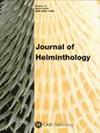Cercarial productivity of redial generations in single-miracidium infections of Lymnaea truncatula with Paramphistomum daubneyi or Fasciola hepatica
IF 1.3
3区 生物学
Q4 PARASITOLOGY
引用次数: 0
Abstract
Single-miracidium infections of瘤蚜或肝吸虫单弧菌感染三疣梭子蟹后代的茧丝生产力
在实验室条件下,通过单弧菌(Paramphistomum daubneyi 或 Fasciola hepatica)感染 Lymnaea truncatula,计算游离红螯蚴及其胚芽,并确定每一代红螯蚴的carcarcarial productivity。在受 P. daubneyi 感染的蜗牛中,第一代(每个红ia 产 8.7 个carcariae)和第二代(每个红ia 产 8.9 个carcariae)产生了carcariae。在接触后第 63 天,它们分别相当于所有红蜗牛所产carcariae 的 53.9% 和 46.1%。在被肝蝇感染的蜗牛中,R2a 组产生的carcariae最多(每红虫产生 18.2 个carcariae),占所有红虫产生的carcariae 的 66.0%。其他再拨组所产生的carcariae数量较为有限:R1b组(28.7%)每redia产生17.5个carcariae,R2b/R3a组(5.3%)每redia产生2.0个carcariae。直到暴露后第 63 天,P. daubneyi 的carcaria 生产力在数量上比 F. hepatica 更有限:每只蜗牛共有 145 个carcariae,而 F. hepatica 则为 427 个。
本文章由计算机程序翻译,如有差异,请以英文原文为准。
求助全文
约1分钟内获得全文
求助全文
来源期刊

Journal of Helminthology
生物-动物学
CiteScore
2.80
自引率
12.50%
发文量
127
审稿时长
3 months
期刊介绍:
Journal of Helminthology publishes original papers and review articles on all aspects of pure and applied helminthology, particularly those helminth parasites of environmental health, medical or veterinary importance. Research papers on helminths in wildlife hosts, including plant and insect parasites, are also published along with taxonomic papers contributing to the systematics of a group. The journal will be of interest to academics and researchers involved in the fields of human and veterinary parasitology, public health, microbiology, ecology and biochemistry.
 求助内容:
求助内容: 应助结果提醒方式:
应助结果提醒方式:


